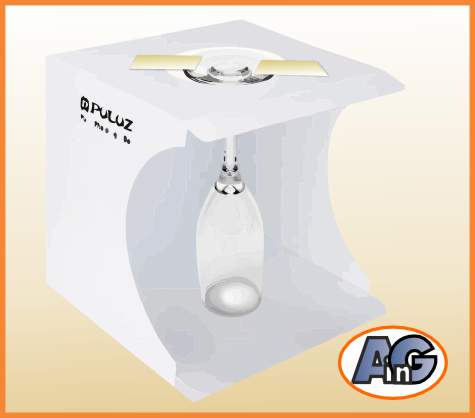The most vulnerable part of a wine glass is its delicate stem. This is also the most difficult part to fix successfully because the area to be glued is very small and a strong bond is therefore hard to achieve.
Fixing broken wine glass stems is difficult and best left to professionals. The handyman can attempt to glue a stem but the repair will seldom be effective. If the glass is of great sentimental value, the best course of action is to bring it to an expert restoration company like Artistry in Glass.
As an Amazon Associate, I earn from qualifying purchases
Stemmed wine glasses are uniquely fragile
Of all household items and collectibles, no object combines such intrinsic fragility with such high rates of use and frequent cleaning as stemmed drinking glasses.
This post has been updated in 2024 to explain the history & utility of stemmed glass, how to take care of them, and how to fix them if the stems get broken. For information on the common problem of chips in rims – jump to this unique guide.
Why do wine glasses have stems?
If stems are so vulnerable why do most wine glasses have them? What are the benefits of stems?
Read this comprehensive post to learn all about why wine glasses have stems.
Follow this link to learn about the history and utility of stemmed glasses.
How to avoid breaking wineglass stems
Everyone knows that prevention is better than a cure – so jump to these sections for ways to avoid damaging your glasses:
- Learn the difference between fine crystal stemware and glass barware
- Decide what kind of parties you enjoy – maybe you don’t need expensive stemware
- Take extra care when washing and storing your crystal by following these tips
- Buy stemless wine glasses instead of stemware
Why is it hard to glue broken wineglass stems?
Gluing the broken stem is a project that can be attempted by the handy homeowner but the outcome is seldom successful because of the following challenges:
The stem is shattered with missing chips
Wine glass stems seldom break into two simple parts. Very often the break is complex, the stem is shattered and small chips are missing. In these cases, simply gluing the stem is not successful.
The gluing area is very small
Even if you have a clean break with no chips missing, the surface area of a broken step (especially a thin crystal stem) is very small. The strength of a glue joint is proportional to the area available for gluing – so even if you do achieve a successful join the glass becomes a display item – it is not safe to use for drinking wine.
The parts are hard to balance
Even if no parts are missing it is difficult to line up and balance the two parts of the stem for gluing.
The bottom line for all gluing jobs is that it is very hard to hold two broken parts together for the 2 to 3 minutes that quick-setting epoxy takes to set up without moving them. And as soon as you move the pieces the join will fail.
What are the solutions? Special tricks from Artistry in Glass
The two keys to successful gluing of thin glass stems are using a fast-setting adhesive and using a special balancing method.
Fast-setting UV-activated adhesive
The most important tip for glass gluing is to use fast-setting, UV-activated adhesive. Jump to this section for our recommended UV adhesives and UV lamps.
UV-activated adhesive is optically clear and sets up in a few seconds under a UV lamp or when exposed to sunlight. We recommend this brand, available on Amazon, as the best value for money.
Special balancing method
Using a stiff but flexible modeling clay such as “Plastilina” (UK = plasticine) we construct a long “pole” that remarkably enables the broken piece to balance. (Special extra hack – use your cell phone to take a closeup of the join and inspect the image closely to make sure the pieces are lined up.)
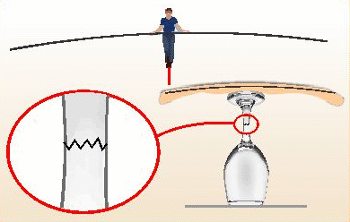
The trick for balancing a glass stem – we use the tightrope walker’s method to balance the glass stem. Using modeling clay like Plastilina as the balance pole.

When you have a stable balance, apply a small drop of UV adhesive to the join – move the two pieces together, double-check the line-up with your cell phone – then, if correct, expose the glue to UV light or sunlight.
The outcome of gluing the stem
Even if you have achieved a good bond and the stem has remained straight rather than crooked, the glass will only be suitable for the display cabinet.
Professional stem repair
If you break a glass that has great sentimental value – an engraved wedding glass, for example, then it may be worth taking the pieces to a professional restorer like Artistry in Glass.
The secret trick of the professional restorer
The key to stem repair is to create a large surface area and therefore a strong glue joint. This is done by cutting off the stem of a “sacrificial” glass that has a similar length stem to the broken one. The stem must be cut in such a way as to include a section of the bottom of the bowl.
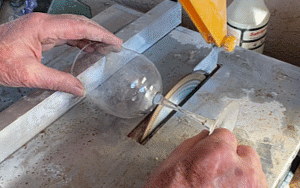
Cutting the stem from a sacrificial wine glass to make a new stem with a large area for gluing. Do not try this at home unless you are experienced in lapidary or similar work.
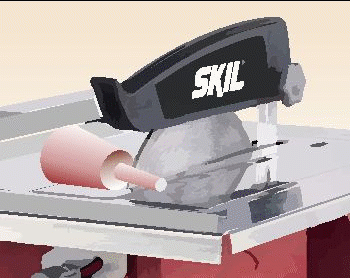
Cutting the damaged stemware close to the base of the bowl to create a large circular area for gluing to the new stem. Use a tile saw like this one available on Amazon.

While polishing the two cut surfaces on the diamond lap (on the old bowl and the new stem), we check that they are level by using a circular bullseye level (like one of these on Amazon.)
Then the moment of truth!
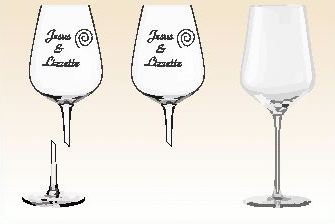
The new stem from the sacrificial glass is lined up with the old bowl and the two parts are glued together with UV-activated glue. If this is successful, the glue joint will be strong enough for the glass to be used (with care – and always washed by hand).
Tucson area customers – bring your broken stemware into Artistry in Glass for expert repair. Insider tip – save money by sourcing your own “sacrificial” wineglass from a thrift store.
The trick for balancing the stem
We have developed the ultimate method for securing the new stem and foot in position while the UV adhesive sets up:
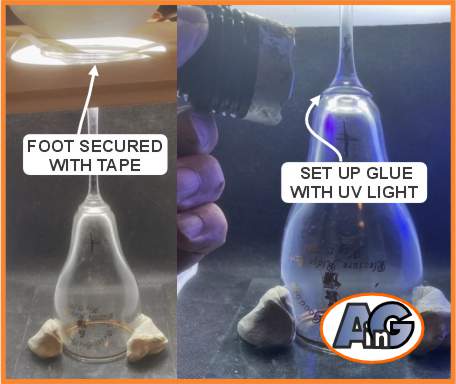
We adjust the Puluz Mini Photo Studio Box – available below from Amazon to hold the new stem and foot in place while gluing with UV-activated glue.
Difficult or impossible stem repair
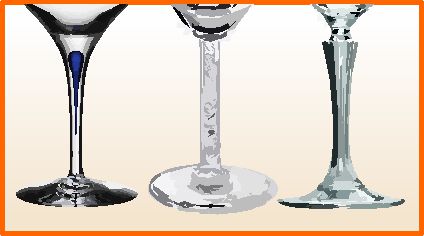
Hard-to-fix stems from classic brands
If you smash one of these decorative stems, you will have to attempt to glue it by carefully piecing the fragments together. It will not be strong enough to use so it will become a display item for the china cabinet.
If you are unfortunate enough to break a valuable Lalique, Orrefors, or Waterford wineglass – why cry over spilled milk? Many classic patterns are still available on Amazon (or try Replacements for discontinued items). Splash out and complete your set by purchasing a new glass!

Phalsbourg by Lalique – fabulous quality – classic crystal from France for the ultimate in self-indulgence
UV adhesives and UV lamps
UV-activated adhesives are indispensable for repairing glass. The ideal UV glue is perfectly clear and non-yellowing and has the very useful characteristic of setting up almost instantly (less than 10 seconds) when exposed to sunlight or an appropriate UV lamp.
Our recommendations for routine gluing of stemware are shown below:

Our favorite lamp is USB-powered, compact, and powerful for curing UV glue. Quickly cure the Jdiction resin shown below.
If you intend to glue glass professionally, high-quality (but expensive) UV glues are available from the CR Laurence company in a variety of viscosities. Choose low-viscosity (very runny) adhesive for filling fine cracks, medium viscosity for most gluing projects, and high viscosity for stemware repair and crack filling.
Easy-to-use kit includes UV-activated glue combined with a handy and small UV lamp – good for detailed gluing of small parts. Available from Amazon
The history of stemmed glasses
The stem already existed on cups made out of metal that were used for holy communion. The stem allowed the priest to lift the chalice up to the congregation for all to see.
Stemmed drinking vessels originated in medieval times as priests needed to raise a glass to present symbolically the blood of Christ to the congregation.
Venetian glassblowers developed Cristallo or crystal glassware in the 15th and 16th centuries and copied the style of religious chalices to create delicate stemware.
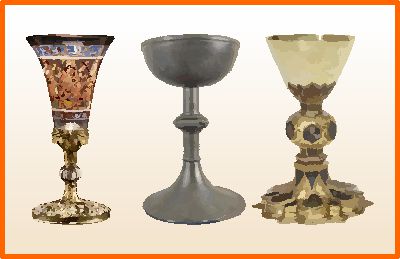
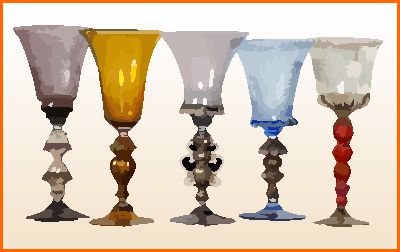
Wine connoisseurs appreciate stemmed glasses
As stemmed glasses became fashionable modern wine lovers came to appreciate them for three main reasons:
- Swirling: holding the stem near the foot, the wine-lover can agitate the wine by swirling. This oxygenates the wine, adding both flavor expression and aroma.
- Maintaining temperature: warming wine by contact with hot hands can spoil the flavor. Holding the glass by the stem avoids warming
- Smudging: the purist dislikes a wineglass bowl with fingerprints or smudges
Follow this link for more information on the fascinating subject of wine stems.
Elegant or rustic – what’s your dining style?
Expensive lead or lead-free crystal glasses are much more delicate than cheap glasses used in bars and restaurants.
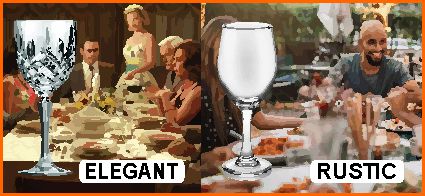
If your style is for elegant dinner parties, then Waterford crystal will certainly impress your guest. Otherwise, why take the risk of expensive broken wineglass stems. Robust barware will fit the zeitgeist of your alfresco meals on the patio and look more honest and authentic.
The difference between fine stemware and barware
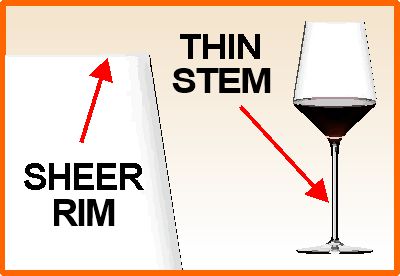
Delicate crystal stemware has sheer rims and thin stems making chips and breakage more likely
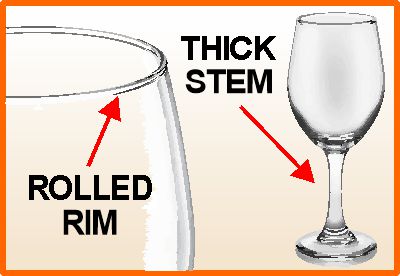
Sturdy barware glasses have rolled rims and thick stems making chips and breakage less likely
Buy stemless wine glasses
Stemless glasses are more appropriate for today’s casual entertaining. Removing the stems makes them appear less formal and more approachable, inviting everyday and casual use.
The lack of stems makes them fit better in cupboards and it’s easy to wash them on the top rack of the dishwasher.

Godinger stemless wine glasses – made in a centuries-old Czech republic factory – out of sparkling lead-free crystal
Tips for the washing and care of stemware
- Remove rings & jewelry before washing crystal
- Wash stemware in warm soapy water – never in the dishwasher
- Place a washcloth in the bottom of the sink
- Hold crystal by the bowl – never the stem
- Never pour very hot liquid into crystal
- Check for water spots before storing your crystal
- Remove water spots with a mixture of vinegar & water
- Do not store crystal stemware resting on its rim
- Never store one crystal glass inside another one
Artistry in Glass was your source for antique repair in Tucson
Check out this amazing selection of informative articles:-
- Where can I get antiques repaired?
- Are broken antiques worth fixing?
- How to fix a broken picture frame
- How to repair a broken china plate
- How to repair a broken china teapot
- How to fix a broken marble slab
- How to repair a broken china coffee mug
- How to repair a 2000-year-old sculpture
- All about repairing stained-glass lampshades
- How to care for your stained glass skylight
- How to repair Dalle de Verre
- Is stained glass worth repairing?
- To repair or toss out?
- Tucson crystal & china repair a division of Artistry in Glass
- What to do with broken antiques
- Is lead crystal dangerous?
- Repairing an antique Mexican statue
- Repairing religious statues
- The history of Swarovski crystal figurines
- How to find the value of a Swarovski Crystal figurine
- Have Swarovski crystal figurines lost value since 2009?
- How to collect Swarovski annual ornaments
- How to display Swarovski crystal figurines
- How to authenticate a Swarovski crystal figurine
- How to display Swarovski annual ornaments
- How to clean Swarovski crystal figurines
- How to repair a Swarovski crystal mouse
- How to repair a Swarovski annual ornament
- How to repair a Swarovski crystal train set
- Fixing broken wine glass stems
- How to clean cloudy glasses
- Why do wine glasses have stems?
- Swarovski Crystal Figurines
- How to repair a chip in a wine glass
- How to fix a scratched glass tabletop
- How to replace a broken patio tabletop





